Optimized at frequencies beyond traditional industry targets to support emerging applications
Different Types Of Potentiometers And How To Use Them In Your Designs
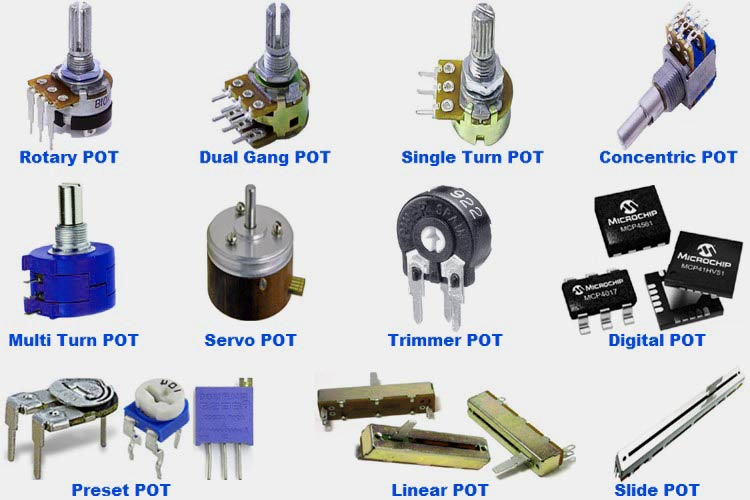
The most elementary component in electronics is the resistors. This humble component can be found almost everywhere from a simple LED circuit to a complex SMPS circuit. We have already discussed the basics of resistors and how they can be used in a circuit. Another important form of resistor that is widely used is the variable resistors or Potentiometers. In this article, we will learn the basics of potentiometers and the types of variable resistors with their applications and significance.
What is a Potentiometer (POT)?
A potentiometer is a variable resistor with three terminals whose voltage is adjustable manually with the help of a movable contact, in order to control the flow of electric current through it. Every variable resistor will have some kind of mechanical or electronic control to vary its resistance, based on the variation of this resistance the voltage across it and current through it is controlled with respect to Ohms Law. The most obvious use of the potentiometer which most of us have spotted is volume control in radios and other audio equipment.
Symbol of a Potentiometer
Being a close relative of resistors, the symbol of a potentiometer also looks very similar to a resistor. The Symbol of the potentiometer is given in the below image, it will have a resistor and an arrow pointing towards the resistor, the arrow represents the sliding contact of the POT. The two ends of the resistor are represented as the terminal 1 & 3 and the wiper end is represented as the terminal 2.
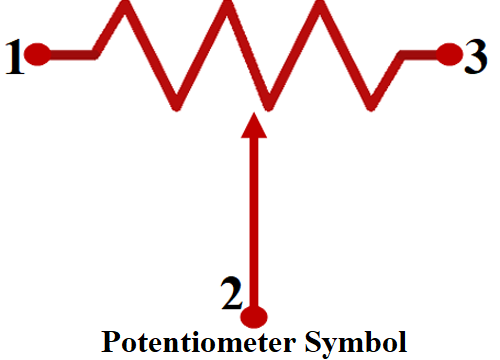
How does Potentiometer work?
A Potentiometer (or) POT is a passive electronic component that has two end terminals with a resistive element and the sliding contact called the wiper acts as the third terminal. The input voltage is applied across the two end terminals and the output is taken between the first end terminal and the sliding contact. The output voltage will be taken across any one of the two input terminals and the sliding contact. The POT helps us to use variable voltages in the same device.
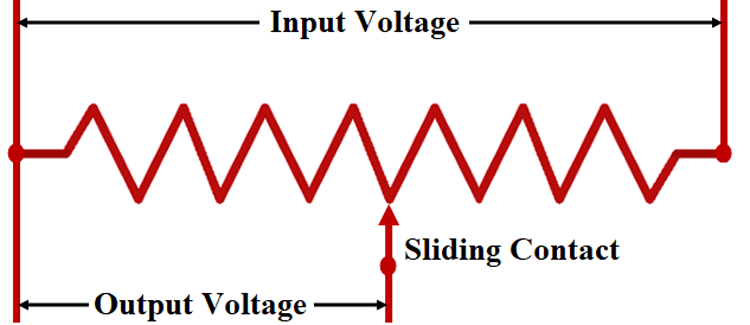
Different Types of Potentiometers
The Potentiometer or POT is manufactured by using different types of materials like carbon composition, cermet, metal film, and conductive plastic. The Potentiometers are classified into three types based on their working, as Rotary potentiometer, Linear potentiometer, and Digital potentiometer. Among these three, the Rotary potentiometer is the most commonly used type of potentiometers.
Rotary Potentiometer
The best example of a rotary potentiometer is the volume controller available in your stereo and other music playing devices where the rotating knob is used to control the supply to the speaker. The Rotary potentiometer can deliver adjustable supply voltage to the electrical and electronic circuits. Both the Rotary potentiometer and the linear potentiometer operates as the same but the only difference is that the rotary potentiometer converts rotary motion into varying resistance

The Rotary POT consists of two terminal contacts (pin 1 and 3) with uniform resistance, it is placed in the shape of a semi-circle and the middle terminal (pin 2) is connected to the resistance through a sliding contact called wiper which is attached with a rotating knob. The knob is rotated to move the sliding contact across the resistance which in turn varies the resistance of the POT. The output is taken between one of the terminals of the semicircle and the terminal attached to the sliding contact.
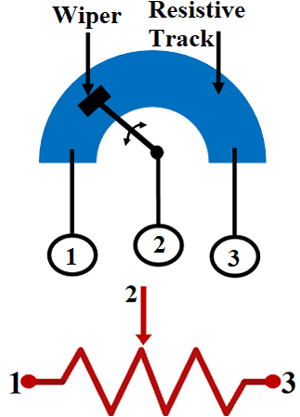
There are many types of Rotary Potentiometer. The popular ones can be classified as single-turn pot, Multi-turn pot, Dual-gang pot, Concentric pot and Servo pot each type of rotary POT has its own purpose and applications.
Single Turn POT
Single Turn Pot can only be rotated to one position which approximately 270 degrees or ¾ of a full turn. Single Turn Pot is mostly used in applications where a single turn can provide enough control resolution.
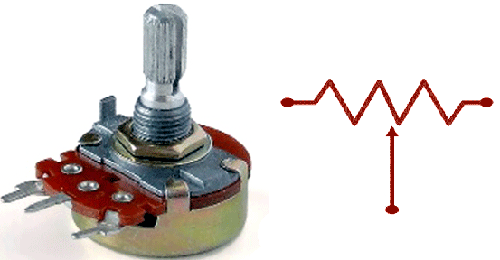
Multi-Turn Pot
The Multi-turn pots are designed with a wiper that is driven on a spiral or helical form, or by using a worm gear. Usually, these pots have multiple numbers of rotations like 5,10 or 20 for increased precision. These pots are mostly used in applications like trim pots on the PCB, that require high precision and resolution. The most popular manufacturer for the multi-turn potentiometer is Bourns. A bourns multiturn potentiometer along with its symbol is shown below.

Dual-gang pot
Dual gang pots are designed by placing two potentiometers together on the same shaft, the single turn pots with equal resistance and taper are mostly preferred for the combination. Although we can add more than two pots in the gangs, it is not very common to do so. Used in stereo audio volume control and other applications where 2 channels have to be adjusted at the same time.
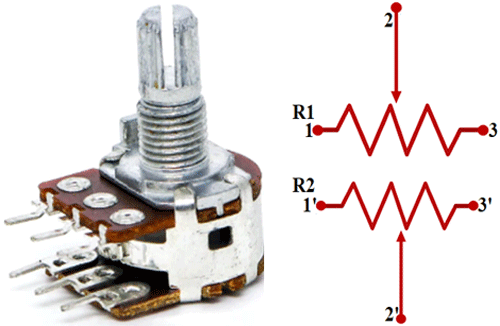
Concentric pot
The name itself reveals its operation, it has two potentiometers that can be adjusted individually by means of concentric shafts. This allows the user to have two controls on the same unit to vary two different resistance. These pots are mostly used in car radios where the volume and tone control are placed together.
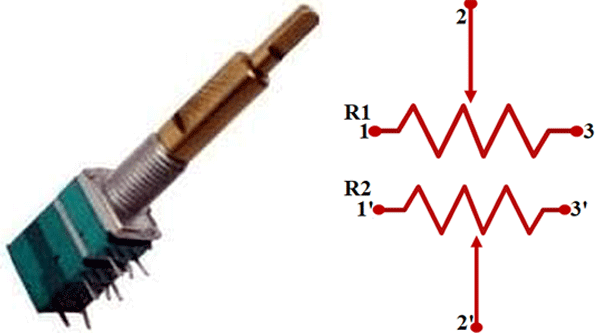
Servo pot
Servo pot has a servo motor attached to the pot, the wiper can be controlled automatically by driving the motor. This type of pot is used in an application that requires both manual and automatic adjustments, mostly in audio equipment where remote control can turn the volume control knob.

Presets and Trimmers
Trimmers or trimpots are a special type of rotary potentiometer that can be fixed once in the circuit and used to make occasional adjustments to the circuit. The rotary wiper on the POT can be adjusted by using a small bladed screwdriver or a similar plastic tool. They are common materials used as the resistive track is either carbon composition or cement. They are available both as an open skeleton and also mounted in a closed square package as shown below.

As they are low cost, small in size, and simple to use, they are mostly preferred in non-critical circuit applications that require adjustments, tuning, and calibrations. The trimpots are available both in a single turn and multi-turn, their common life span ranges from only 100-200 cycles. When the Trimmer used as a variable resistor in a circuit it is called a Preset Potentiometer.
Linear Potentiometer
Linear Potentiometer has a similar function as the rotary potentiometer, but instead of the semi-circular resistance, there will be a linear resistor here with a sliding contact. The two ends of the linear resistor are connected across the source or input voltage, the output is taken between the sliding contact and anyone end of the linear resistor. The linear pots are commonly used for measuring the voltage across a branch of a circuit, for measuring the internal resistance of a battery cell and also for comparing a battery cell with a standard cell.
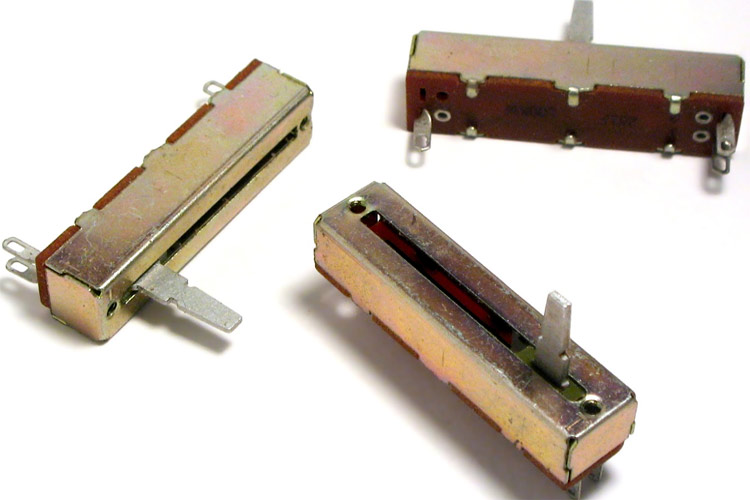
Like Rotary Pots, linear pots are also available in different types for different applications. The different types of linear pots include slide pot, dual-slide pot, multi-turn slide, and motorized fader.
Slide Pot
The slide pot is a single linear slider potentiometer which is also called the fader. The fader is constructed with conductive plastic. These are mostly used for audio applications and single-channel control or measurement of distance.

Dual Slide Pot
The Dual Slide Pot consists of a single slider that can be used to control two potentiometers in parallel. They are often used for stereo control in professional audio and other applications where dual parallel channels are controlled.
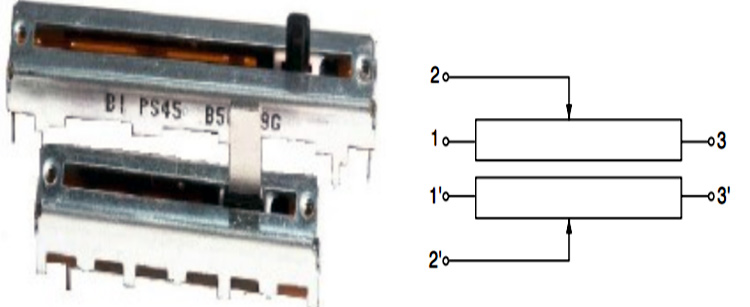
Multi-Turn Slide
The multi-turn slide is designed with a spindle that activates the linear potentiometer wiper, this pot has multiple rotations for increased precision. They are often used in applications like trim pots on the PCB, that require high precision and resolution.
Motorized Fader
This is a type of fader that can be automatically controlled by a servo motor. These faders are used in applications that require both manual and automatic adjustment. Most commonly used in studio audio mixers where the servo fader is used to automatically move to a saved configuration.
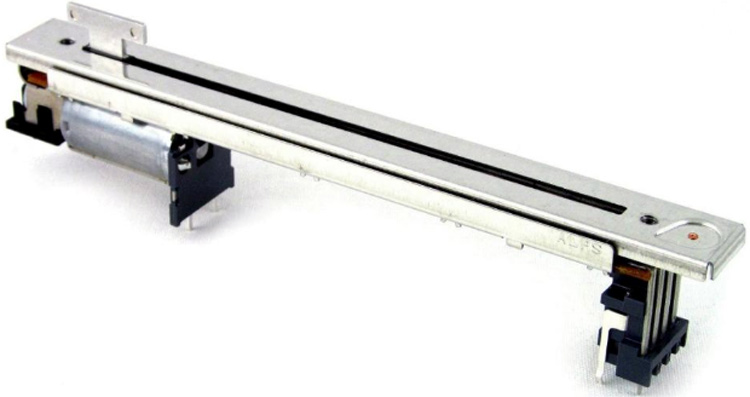
Digital Potentiometers
The rotary and linear potentiometers are mechanical potentiometers, there are few disadvantages in them like accuracy variations. The Digital Potentiometers or Digi POT can provide the most accurate measurements among the different types of potentiometers. Size, resistance drift, wiper contamination, humidity, mechanical wear, sensitivity to vibration, etc. are some of the other disadvantages of mechanical potentiometers.
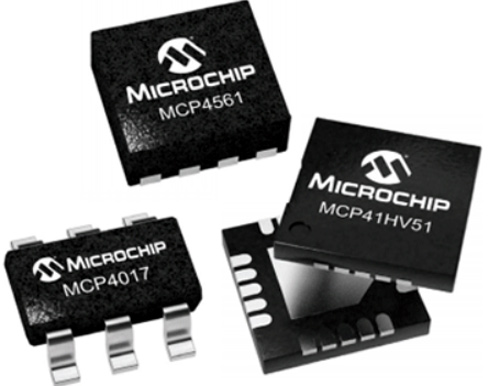
The Digital potentiometers aren’t affected by any of the environmental facts like vibrations, humidity, shocks and wiper contamination and overcome all the disadvantages of the mechanical potentiometers. They provide advantages like high reliability, increased accuracy, negligible resistance drift, very low power dissipation, etc. The M62429 Digipot from Renesas and MCP41010 from microchip are a few of the popular digital potentiometer ICs.
Standard Values of Potentiometers
The potentiometer is variable and we can fix different values of resistance in the same potentiometer, but to reduce the complexity and size of the circuit, we are presented with a different option on resistance value. Most of the potentiometers will have the resistance values in the multiples of 10,20,22,25,47 and 50. Although we have a lot of option the most commonly used potentiometers are valued as 10kΩ, followed by 1kΩ, 5kΩ, and 100kΩ.
Marking Codes
The potentiometer’s value is mostly marked on top of the device as an exact value like 100K for a 100KΩ potentiometer. Sometimes they are represented as a three-digit code, the first two digits of the code represent the value of the POT and the last digit represents the multiplier.
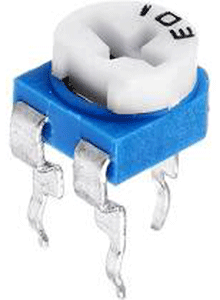
For example, consider the three-digit code on the pot as 103, as is said we can expand the code as 10Ω x 103 = 10 kΩ, This means that the potentiometer of value 10KΩ will have a marking “103” as shown above.








